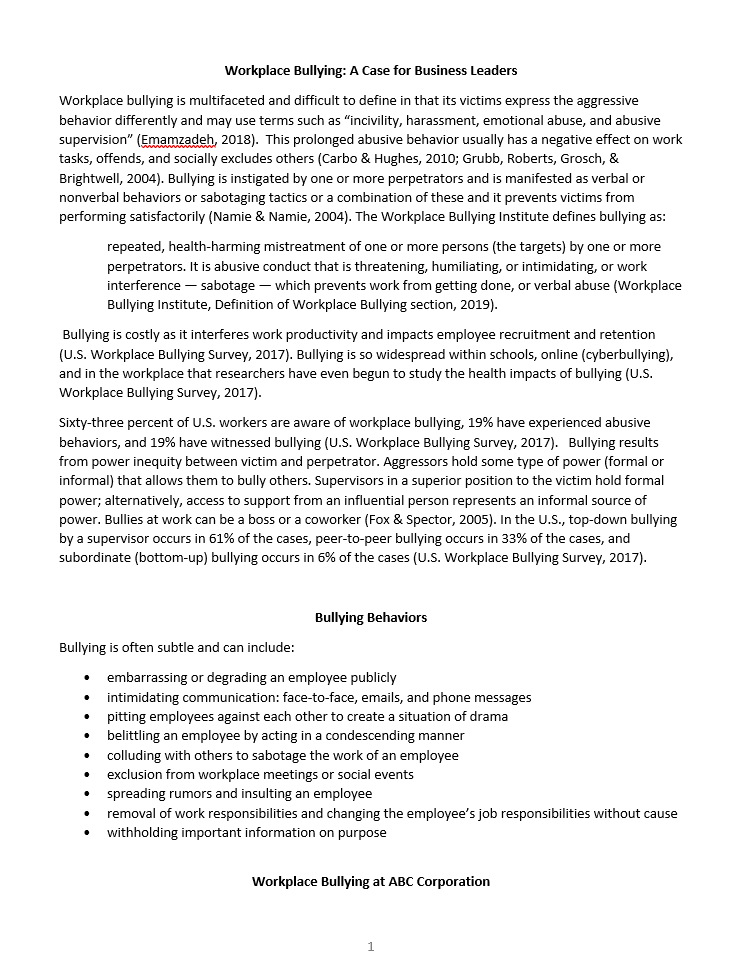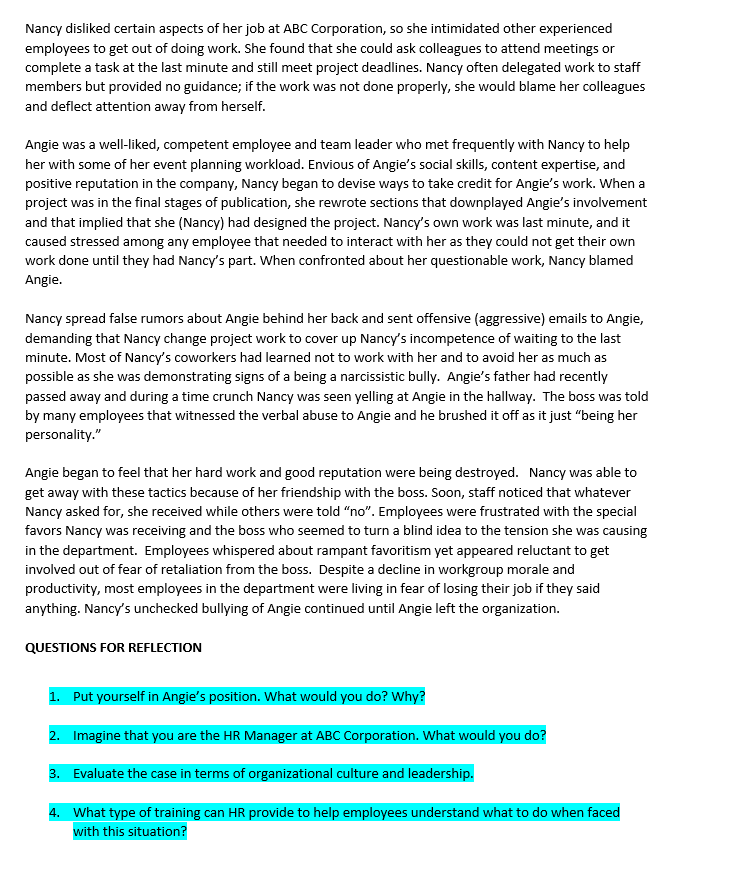Answered step by step
Verified Expert Solution
Question
1 Approved Answer
QUESTIONS FOR REFLECTION Put yourself in Angies position. What would you do? Why? Imagine that you are the HR Manager at ABC Corporation. What would


QUESTIONS FOR REFLECTION
- Put yourself in Angies position. What would you do? Why?
- Imagine that you are the HR Manager at ABC Corporation. What would you do?
- Evaluate the case in terms of organizational culture and leadership.
- What type of training can HR provide to help employees understand what to do when faced with this situation?
Workplace Bullying: A Case for Business Leaders Workplace bullying is multifaceted and difficult to define in that its victims express the aggressive behavior differently and may use terms such as "incivility, harassment, emotional abuse, and abusive supervision" (Emamzadeh, 2018). This prolonged abusive behavior usually has a negative effect on work tasks, offends, and socially excludes others (Carbo \& Hughes, 2010; Grubb, Roberts, Grosch, \& Brightwell, 2004). Bullying is instigated by one or more perpetrators and is manifested as verbal or nonverbal behaviors or sabotaging tactics or a combination of these and it prevents victims from performing satisfactorily (Namie \& Namie, 2004). The Workplace Bullying Institute defines bullying as: repeated, health-harming mistreatment of one or more persons (the targets) by one or more perpetrators. It is abusive conduct that is threatening, humiliating, or intimidating, or work interference - sabotage - which prevents work from getting done, or verbal abuse (Workplace Bullying Institute, Definition of Workplace Bullying section, 2019). Bullying is costly as it interferes work productivity and impacts employee recruitment and retention (U.S. Workplace Bullying Survey, 2017). Bullying is so widespread within schools, online (cyberbullying), and in the workplace that researchers have even begun to study the health impacts of bullying (U.S. Workplace Bullying Survey, 2017). Sixty-three percent of U.S. workers are aware of workplace bullying, 19% have experienced abusive behaviors, and 19% have witnessed bullying (U.S. Workplace Bullying Survey, 2017). Bullying results from power inequity between victim and perpetrator. Aggressors hold some type of power (formal or informal) that allows them to bully others. Supervisors in a superior position to the victim hold formal power; alternatively, access to support from an influential person represents an informal source of power. Bullies at work can be a boss or a coworker (Fox \& Spector, 2005). In the U.S., top-down bullying by a supervisor occurs in 61% of the cases, peer-to-peer bullying occurs in 33% of the cases, and subordinate (bottom-up) bullying occurs in 6\% of the cases (U.S. Workplace Bullying Survey, 2017). Bullying Behaviors Bullying is often subtle and can include: - embarrassing or degrading an employee publicly - intimidating communication: face-to-face, emails, and phone messages - pitting employees against each other to create a situation of drama - belittling an employee by acting in a condescending manner - colluding with others to sabotage the work of an employee - exclusion from workplace meetings or social events - spreading rumors and insulting an employee - removal of work responsibilities and changing the employee's job responsibilities without cause - withholding important information on purpose Workplace Bullying at ABC Corporation 1 Nancy disliked certain aspects of her job at ABC Corporation, so she intimidated other experienced employees to get out of doing work. She found that she could ask colleagues to attend meetings or complete a task at the last minute and still meet project deadlines. Nancy often delegated work to staff members but provided no guidance; if the work was not done properly, she would blame her colleagues and deflect attention away from herself. Angie was a well-liked, competent employee and team leader who met frequently with Nancy to help her with some of her event planning workload. Envious of Angie's social skills, content expertise, and positive reputation in the company, Nancy began to devise ways to take credit for Angie's work. When a project was in the final stages of publication, she rewrote sections that downplayed Angie's involvement and that implied that she (Nancy) had designed the project. Nancy's own work was last minute, and it caused stressed among any employee that needed to interact with her as they could not get their own work done until they had Nancy's part. When confronted about her questionable work, Nancy blamed Angie. Nancy spread false rumors about Angie behind her back and sent offensive (aggressive) emails to Angie, demanding that Nancy change project work to cover up Nancy's incompetence of waiting to the last minute. Most of Nancy's coworkers had learned not to work with her and to avoid her as much as possible as she was demonstrating signs of a being a narcissistic bully. Angie's father had recently passed away and during a time crunch Nancy was seen yelling at Angie in the hallway. The boss was told by many employees that witnessed the verbal abuse to Angie and he brushed it off as it just "being her personality." Angie began to feel that her hard work and good reputation were being destroyed. Nancy was able to get away with these tactics because of her friendship with the boss. Soon, staff noticed that whatever Nancy asked for, she received while others were told "no". Employees were frustrated with the special favors Nancy was receiving and the boss who seemed to turn a blind idea to the tension she was causing in the department. Employees whispered about rampant favoritism yet appeared reluctant to get involved out of fear of retaliation from the boss. Despite a decline in workgroup morale and productivity, most employees in the department were living in fear of losing their job if they said anything. Nancy's unchecked bullying of Angie continued until Angie left the organization. QUESTIONS FOR REFLECTION 1. Put yourself in Angie's position. What would you do? Why? 2. Imagine that you are the HR Manager at ABC Corporation. What would you do? 3. Evaluate the case in terms of organizational culture and leadership. 4. What type of training can HR provide to help employees understand what to do when faced with this situation
Step by Step Solution
There are 3 Steps involved in it
Step: 1

Get Instant Access to Expert-Tailored Solutions
See step-by-step solutions with expert insights and AI powered tools for academic success
Step: 2

Step: 3

Ace Your Homework with AI
Get the answers you need in no time with our AI-driven, step-by-step assistance
Get Started


